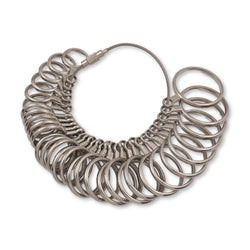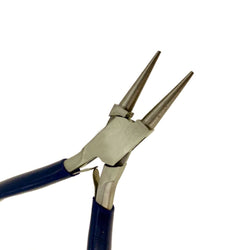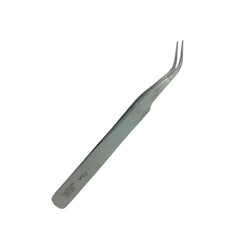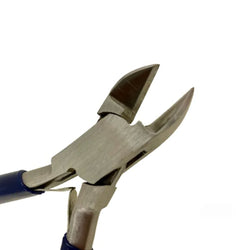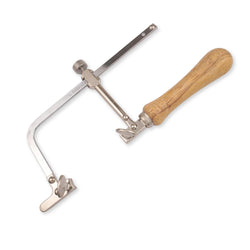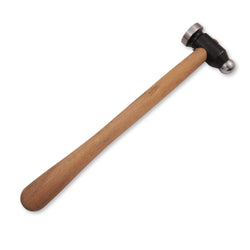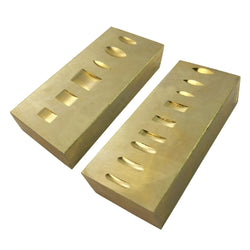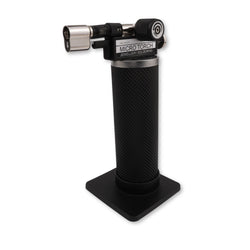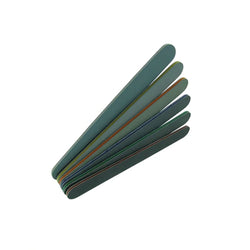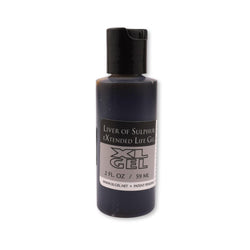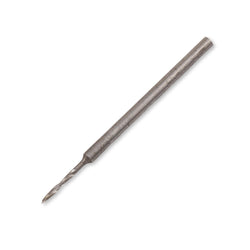Werkzeuge zur Schmuckherstellung
Handwerkliche Schmuckwerkzeuge
Entdecken Sie eine Welt, in der Effizienz auf Innovation trifft. Unsere Werkzeuge sind so ausgewählt, dass sie Ihren Arbeitsablauf optimieren und Ihnen die Arbeit mit einer Vielzahl von Materialien und Techniken ermöglichen.
Ob Sie empfindliche Metalle formen, Edelsteine fassen oder maßgeschneiderte Kreationen polieren, unsere Werkzeuge bieten die Zuverlässigkeit und Kontrolle, die für makellose Ergebnisse erforderlich sind.
Mit ergonomischem Design und langlebiger Konstruktion verspricht jedes Element unserer Kollektion eine wertvolle Ergänzung Ihres Werkzeugkastens zu sein und sicherzustellen, dass Sie sich darauf konzentrieren können, Ihre visionären Designs mit Leichtigkeit und Präzision zum Leben zu erwecken.
Häufig gestellte Fragen
Um mit der Schmuckherstellung zu beginnen, benötigen Sie einen grundlegenden Satz an Werkzeugen für grundlegende Aufgaben. Zu den unverzichtbaren Werkzeugen gehören Zangen zum Biegen von Draht und Herstellen von Schlaufen, Drahtschneider zum Beschneiden von Metallen und eineJuweliersäge für komplizierte Schnitte.
Für detaillierte Arbeiten ist ein Satz feiner Feilen unverzichtbar. Ein Set an Schleifutensilien und Poliergeräten ist unerlässlich, um Ihren Projekten ein Hochglanzfinish zu verleihen.
Wenn Sie in diese Schlüsselwerkzeuge aus unserer Kollektion investieren, stellen Sie sicher, dass Sie über die Qualität und Präzision verfügen, die Sie für die Herstellung wunderschöner, handgefertigter Stücke benötigen.
Absolut! Hochwertige Werkzeuge können die Effizienz, Präzision und das Endergebnis Ihrer Schmuckherstellung erheblich beeinflussen.
Diese Werkzeuge bestehen aus hochwertigen Materialien, die besseren Halt, präzisere Schnitte und eine feinere Kontrolle bieten. Dies verbessert nicht nur die Qualität Ihrer Arbeit, sondern kann auch die Ermüdung der Hände verringern und längere Arbeitssitzungen ermöglichen.
Entdecken Sie unsere Sammlung professioneller Werkzeuge, die auf Langlebigkeit und außergewöhnliche Leistung ausgelegt sind und Ihr handwerkliches Können und den Wert Ihrer Kreationen steigern.
Natürlich! Wenn Sie Probleme mit einem der Schmuckherstellungswerkzeuge haben, die Sie in unserem Sortiment erworben haben, steht Ihnen unser Kundendienstteam gerne zur Verfügung.
Wir wissen, dass die Beherrschung neuer Tools eine Herausforderung sein kann. Deshalb bieten wir Ihnen individuelle Unterstützung bei der Lösung etwaiger Probleme.
Zögern Sie nicht, uns über unsere Support-Seite zu kontaktieren, wo unsere erfahrenen Experten in der Schmuckherstellung Ihnen gerne mit Rat und Tat zur Seite stehen, damit Ihr Bastelerlebnis reibungslos und angenehm verläuft.
Ihre Zufriedenheit und Ihr Erfolg bei der Schmuckherstellung stehen für uns an erster Stelle!
Choosing the best pliers depends on your specific needs. Round nose pliers are ideal for making loops and curves, flat nose pliers are perfect for gripping and bending, while chain nose pliers are great for getting into tight spaces. Look for pliers with ergonomic handles for comfort during extended use, and ensure they are made from durable, rust-resistant materials for longevity.
The best saw blades for metal cutting in jewellery making depend on the specific application. Finer blades, such as those with smaller teeth, are ideal for smaller, intricate, and cleaner cuts, making them perfect for delicate designs. On the other hand, blades with larger teeth are better suited for thicker cuts, providing the necessary strength to cut through heavier materials. It's important to match the blade size and tooth count to the thickness and intricacy of the metal work you're performing to achieve the best results.
For smoothing metal in jewellery making, start with a coarse grade sandpaper (400-600 grit) to remove larger scratches and shape the piece. Then, progress to finer grits depending on the level of polish you're aiming for. As you move up to finer grits, such as 800-1200 grit, you’ll refine the surface further. For a high polish, continue with even finer sandpapers, going up to 3000 grit. This progression ensures that you achieve the desired smoothness and polish on your jewellery pieces.
A bezel pusher is used in stone setting to gently press the metal bezel over the edge of a gemstone, securing it in place. Start by positioning the pusher against the bezel and applying even pressure as you work around the stone. Ensure that the bezel is evenly pressed without damaging the stone, resulting in a secure and professional-looking setting.
Jewellery crafting utilizes various hammers, including ball-peen hammers for shaping metal, chasing hammers for texturing, and rawhide mallets for working with soft metals without leaving marks. Choosing the right hammer depends on the specific task, whether it’s shaping, texturing, or finishing your jewellery piece.
Polishing compounds are used in the final stages of jewellery making to remove fine scratches and bring out the metal's shine. Compounds like Tripoli are used for initial polishing, while rouge is used for a high-gloss finish. Applying these compounds with a polishing wheel or cloth results in a professional, mirror-like finish on your jewellery pieces.
Hallmarking stamps are crucial in jewellery making because they certify the metal's purity and authenticity, ensuring compliance with legal standards. Stamping your jewellery with a hallmark not only adds value but also builds trust with customers, indicating that your pieces are made with high-quality materials.
When selecting soldering tools, consider the type of metal you’re working with, the solder’s melting point, and the complexity of the join. Essential tools include a soldering torch, flux, and solder in various forms (wire, paste). A soldering block and tweezers are also necessary for precision. Choosing the right tools ensures clean, strong joints in your jewellery.
Tweezers are used in jewellery making for handling small components, positioning stones, and holding pieces in place while soldering. Precision tweezers with fine, pointed tips are ideal for detailed work, ensuring that small parts are securely held and accurately placed without damage.
Ergonomic tools reduce strain on your hands and wrists during prolonged use, making jewellery making more comfortable and preventing repetitive strain injuries. Tools with cushioned, non-slip grips and well-balanced designs allow for greater control and precision, enhancing the quality of your work.
Micro drill bits are best suited for jewellery making because they allow for precise drilling in small, delicate pieces of metal or gemstones. They are ideal for creating holes for settings, rivets, or clasps, where accuracy is crucial. Using high-quality, sharp micro drill bits ensures clean, precise holes that enhance the overall finish of your jewellery.
To properly oxidize metal in jewellery making, use an oxidizing solution like liver of sulfur, which darkens the metal by forming a patina. Clean the metal thoroughly before application, then dip or paint on the solution. After achieving the desired colour, rinse and dry the piece. Oxidizing adds depth and contrast to your jewellery designs, highlighting intricate details.
Critical measuring tools for jewellery making include callipers for measuring thickness and diameter, a metal ruler for straight lines, and a micrometre for precision measurements. Accurate measurements are essential in ensuring that components fit together properly, leading to a professional finish in your jewellery pieces.
To maintain and care for your jewellery making tools, regularly clean them after use to remove debris and prevent rust. Store tools in a dry, organized space to avoid damage. Sharpen cutting tools and replace worn parts as needed to ensure they function properly. Proper maintenance extends the life of your tools and keeps them in optimal working condition.
Choose cutters based on the material's hardness and thickness. For soft metals like copper or silver, use flush cutters for clean cuts. For thicker or harder materials, opt for heavy-duty wire cutters. Having a range of cutters ensures that you can handle various materials without damaging the tools or the workpiece.
To make your jewellery making process more sustainable, use recycled metals and ethically sourced gemstones. Opt for eco-friendly tools and materials, reduce waste by recycling scrap metal, and choose suppliers committed to sustainable practices. Sustainable jewellery making not only benefits the environment but also appeals to conscientious consumers.
Common tools for stone setting include bezel pushers, prong pushers, burnishers, and setting pliers. These tools help secure stones into their settings with precision and stability, ensuring that the stones are aligned and firmly held in place. Using the correct tools is essential for achieving professional-quality stone settings.
Sanding is a crucial step in finishing jewellery, as it smooths out imperfections and prepares the surface for polishing. By using progressively finer grits of sandpaper, you can remove scratches, shape the piece, and achieve a smooth finish, which is essential for a polished, professional appearance.
Delicate jewellery crafting requires precision tools such as fine-tipped pliers, needle files, and micro drill bits. These tools allow for careful handling and detailed work on small or fragile components, ensuring that delicate pieces are crafted with accuracy and finesse.
To correctly use hallmarking stamps, position the stamp on the metal surface where the mark is to be made. Strike the stamp with a hammer firmly but gently, ensuring a clear and distinct imprint. Proper hallmarking certifies the quality and authenticity of your jewellery, adding value and trustworthiness to your pieces.
Store your jewellery making tools in a dry, organized space such as a tool chest or drawer with compartments. Use protective covers for sharp tools, and keep tools separated to avoid damage. Regularly check for signs of rust or wear and address any issues immediately. Safe storage prolongs the life of your tools and keeps them in good working order.
The best tools for cutting metal sheets in jewellery making include jeweller’s saws with fine blades, metal shears, and disc cutters. These tools provide clean, precise cuts that are essential for shaping metal sheets into components for your designs. Choosing the right cutting tool depends on the thickness and type of metal you are working with.
For wire work in jewellery making, round nose pliers are best for creating loops, chain nose pliers are ideal for gripping and bending wire, and flat nose pliers help with making straight bends. These pliers allow for precise manipulation of wire, which is crucial for creating intricate wirework designs.
The most basic jewellery equipment includes a set of pliers (round nose, flat nose, and chain nose), cutters, a jeweller’s saw, a bench peg, files, and a hammer. These tools form the foundation of any jewellery maker’s toolkit, allowing you to perform essential tasks such as cutting, shaping, and assembling metal. Starting with these basic tools, you can begin creating a variety of jewellery pieces with precision and ease.

